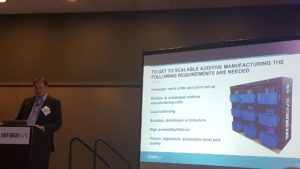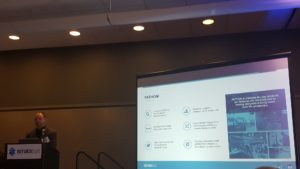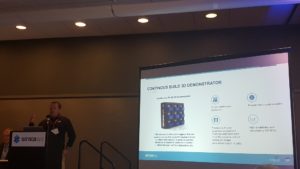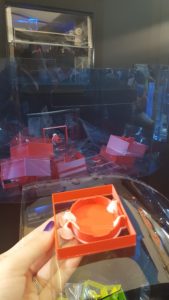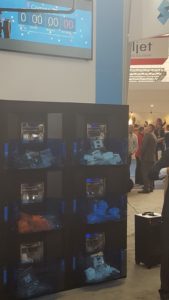Stratasys Fills In the Blanks on Continuous Build 3D Demonstrator, Extended Desktop Metal 3D Printing Partnership
 At RAPID + TCT last week in Pittsburgh, the air was thick with announcements of the latest (and greatest?) in 3D printing. For its part, Stratasys hosted its announcements with great fanfare, and I had the opportunity to join the media crowd gathered Monday night for a dinner and Tuesday morning for the full press conference announcing the new Continuous Build 3D Demonstrator and news of Stratasys’ extension of its partnership with RAPID + TCT darling Desktop Metal. These announcements did not disappoint, and indeed show already-demonstrable applications as 3D printing continues to grow as an industry. In talking with other attendees ahead of the announcements, speculation centered around two main areas that Stratasys might have had in mind with the extensive schedule for those invited to their events — and, indeed, both predictions proved accurate as we ultimately heard about another 3D demonstrator, building on technology initially announced and showcased at IMTS in the autumn, as well as news of involvement in metal 3D printing.
At RAPID + TCT last week in Pittsburgh, the air was thick with announcements of the latest (and greatest?) in 3D printing. For its part, Stratasys hosted its announcements with great fanfare, and I had the opportunity to join the media crowd gathered Monday night for a dinner and Tuesday morning for the full press conference announcing the new Continuous Build 3D Demonstrator and news of Stratasys’ extension of its partnership with RAPID + TCT darling Desktop Metal. These announcements did not disappoint, and indeed show already-demonstrable applications as 3D printing continues to grow as an industry. In talking with other attendees ahead of the announcements, speculation centered around two main areas that Stratasys might have had in mind with the extensive schedule for those invited to their events — and, indeed, both predictions proved accurate as we ultimately heard about another 3D demonstrator, building on technology initially announced and showcased at IMTS in the autumn, as well as news of involvement in metal 3D printing.
During the press conference, Scott Crump, Stratasys’ Founder and Chief Innovation Officer, shared his vision of what makes the new Continuous Build 3D Demonstrator notable:
“These are exciting times in the additive manufacturing world. Now you can print from anywhere to anywhere at any time, producing the exact same part you’re going to expect. Visualize a wave of 5,000 parts per day, way different from way industry is today. This system has enabled us to install at our development customers and have now printed tens of thousands of parts, this is not just a concept, this is in actual practice in the field today. I invite you to see 10,000 parts in our booth here today.”
The system, Crump explained, can:
- Optimize part and set up build
- Print job
- Automatically eject completed part
- Request next job in queue, repeat
“All with limited human intervention,” he emphasized. “That’s not been done in the industry for the last 30 years. Stratasys is honored to provide this for the first time in our industry, unveiling this today. This is not sending job to a specific printer, but to the cloud; the capacity is the sum of all available printers in the array. It’s easy to expand capacity to meet demand by adding production cells to the array, driven by the same GrabCAD software.”
The 3D Demonstrators are taking Stratasys forward — the company has before noted “a quantum step forward” — as additive manufacturing takes its place in the broader manufacturing industry and addresses real-use scenarios. With the newest 3D Demonstrator, we see Stratasys continuing to look to larger-scale 3D printing by using, not as with its other demonstrators, large build areas, but many build areas. The Continuous Build 3D Demonstrator initially evokes a familiar feeling, as an onlooker may feel they have seen this before in 3D printer farms of networked desktop 3D printers working together. That, however, is not what’s happening here, and I talked with Stratasys’ Director of North American Sales Enablement, Roger Kelesoglu, to clarify more about what the company is bringing to the table with this not-a-print-farm offering.
“Thing-having is better than idea-having,” he agreed with a smile as we discussed the customers already working with this just-announced technology.
I may have encouraged the lightness of phrasing in that statement, but the sentiment is an important one: Stratasys is taking steps to ensure that announcements made are provable, verified, and realizable in real world conditions with real world customers.
“I’m very excited about this,” he said, “because this is real. It’s a relatively small lift for someone to see Stratasys coming with this, with an automated, cloud-based continuous production; this is a reasonable technology challenge to take on. We’re developing use cases for particular customer needs. We have experience with this kind of introduction work with our customers today. Unlike our other Demonstrators that are more forward-looking, this realness is exciting. We’re making thousands of products today.”
The three customers initially announced as working with Continuous Build 3D Demonstrator technology — Savannah College of Art and Design (SCAD), In’Tech Industries, and FATHOM, representatives from each of which spoke at the press conference — are not indicative of the entire installed base of these systems, as there is also at least one system in Europe, and several customers, as with any newly installed technology, do not (yet) wish to be named.
“Today’s named customers show what is unique to what Stratasys has to offer,” Kelesoglu told me. “We have some differentiators in solving for these opportunities.”
With each new claim of each new technology, or packaging of technology, there is always a tentative time thereafter in which we must sit back and see beyond the enthusiasm of a press conference to discover where the real differentiation lies. For the Continuous Build 3D Demonstrator, Kelesoglu was only too happy to fill in the blanks on this, emphasizing that the system is not a print farm. Especially with the announcement being somewhat predicted among those watching the company, it was interesting to hear his perspective on where the new Fortus-powered system fits into the larger Stratasys portfolio and plan.
“This is a logical extension to what we’re doing — but it’s transformative. You don’t have to wrap your head around a new technology to get there… This is pretty special, it’s not just a bunch of printers on a rack. The most amazing designs are often the most simple and elegant. This is an integration of superior cloud-based capabilities. It’s logical; it hasn’t been done before in 3D printing, integration to the extent done here. Now we can play in this playground, at production-scale. The reception has been good; people get it. The implications are picking up momentum. It’s accessible, which is different from other announcements. With these kinds of announcements, the challenge is in making them real.”
When we look at traditional plastic needs for tooling, with 10,000-20,000 parts made, costs of tooling aren’t an issue — but in lower-volume production, Kelesoglu noted, this precludes some companies as ingredients and components are required to scale for 1,000-5,000 parts. One constraint lies in the need for an operator to stand in front of a machine. The cloud-based system at play in this technology can be “transformative on scale and cost.” The ability to operate “lights-out” as the machines run themselves, with no pause or stop until the run is complete, is “pretty powerful,” he said, adding:
“You can connect the dots to see how you can produce 5,000 parts; this is new in additive manufacturing. It’s transformative when you see parts cascading out of the machine and getting to thousands.”
 It is important to note that for all the realism of this machine, it is not (yet?) commercially available.
It is important to note that for all the realism of this machine, it is not (yet?) commercially available.
Following the announcement of the Continuous Build 3D Demonstrator was, of course, news of the extension of Stratasys’ relationship with Desktop Metal. Stratasys invested in Desktop Metal early on, and now the younger company will have access to Stratasys’ distribution network.
“This is a good thing for our customers, for channels to bring to market. It’s an evolution of our relationship; now is the time to announce as they unveil their products,” Kelesoglu noted. “We’re very early in that, as we work with partners. We’ll see that evolve over time. We have work to do, to introduce the right customers to the right technology. We’re now at the beginning of introducing this technology which is very compelling, as we strengthen our channel and the options and choices our customers have.”
During the press conference, Desktop Metal’s CEO and Co-Founder, Ric Fulop, expressed his company’s feelings as well about the expanding partnership — as well as a nod to the fact that it may yet expand further in the future.
“I’m very excited to be partnering with Stratasys, we’ve been collaborating since before we started the company, and have exchanged ideas,” Fulop said. “We’ll start with sales, and will do more things together, I think there’s lots of creative people at both companies, so we’re excited to work together. This comes together from a customer perspective to offer more. There are a lot of ways to potentially work together. We’ll look to more collaboration; we’ve already been working closely for several years, and now we’ll be working even closer.”
Kelesoglu’s thoughts on Stratasys’ latest moves are helpful as always, as he has previously shed light on last year’s J750 3D printer launch, and as I met with him a few months ago at SOLIDWORKS World to talk about rapid prototyping solutions. I had the opportunity as well at RAPID + TCT to catch up with Fulop and his team to discuss more about Desktop Metal and its emerging place in the 3D printing industry. We’ll be keeping an eye out for all that Stratasys and its partners, as well as Desktop Metal and its partnerships, have to offer. Discuss in the Stratasys forum at 3DPB.com.
[All photos: Sarah Goehrke]
Subscribe to Our Email Newsletter
Stay up-to-date on all the latest news from the 3D printing industry and receive information and offers from third party vendors.
You May Also Like
Changing the Landscape: 1Print Co-Founder Adam Friedman on His Unique Approach to 3D Printed Construction
Additive construction (AC) is much more versatile than it seems, at first: as natural as it is to focus on the exciting prospect of automated home construction, there’s far more...
US Army Corps of Engineers’ Megan Kreiger on the State of Construction 3D Printing
Despite last year’s gloomy reports about the financial state of the additive manufacturing (AM) industry, there’s no doubt that we’re actually witnessing the birth of a sector rather than its...
3D Printing Webinar and Event Roundup: April 21, 2024
It’s another busy week of webinars and events, starting with Hannover Messe in Germany and continuing with Metalcasting Congress, Chinaplas, TechBlick’s Innovation Festival, and more. Stratasys continues its advanced training...
Profiling a Construction 3D Printing Pioneer: US Army Corps of Engineers’ Megan Kreiger
The world of construction 3D printing is still so new that the true experts can probably be counted on two hands. Among them is Megan Kreiger, Portfolio Manager of Additive...


